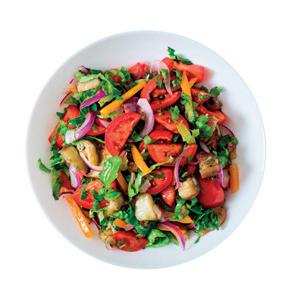
16 minute read
FUEL
38 STUDENT HEALTH GUIDE FUEL
An active lifestyle and a healthy diet are key to a happy life and a great physique…
What you put into your body plays a huge part in your outward appearance, your mood, your mental health and how active you are. If you eat and drink well, you’ll be alert, focused and bursting with energy.
Getting the balance right Forget faddy diets that ban certain foods, such as ‘no carbs before Marbs’ and Beyoncé’s maple-syrup diet. They may show results initially, but they’re not achievable in the long term. Instead, go for a healthy, balanced diet and reap these benefits…
Control weight Variety is the spice of life, and a balanced diet certainly helps maintain a healthy weight. Eat five portions of fruit and vegetables a day – they’re lowcal but high in nutrients.
Combat diseases Eating a good range of vitamin and mineral-packed foods helps prevent certain health conditions – such as heart disease and strokes – and also maintains your cholesterol and blood pressure levels.
Boost energy By eating the right food in the right amounts, you’ll have more energy to exercise. This improves muscle strength, creates a toned physique and improves your endurance.
Relationship between diet and mental health Whilst research is still being conducted, it’s heartening to hear that nearly two thirds of people who don’t report mental health problems eat fresh fruit and vegetables every day, compared to less than half of those with mental health issues. Whilst a change in diet is unlikely to cure mental health issues entirely, it’s certainly likely to have a positive effect.
CHECK THE LABEL ON PACKAGED FOODS Check the traffic light system means neither high nor low, but when selecting packaged take care with lots of red, as foods. The more green on the these often contain the most label, the healthier it is. Amber sugar and fat.
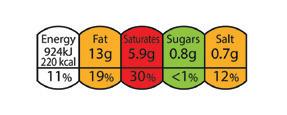
For more tips on how to tweak what’s on your plate to feel great, head to page 40.
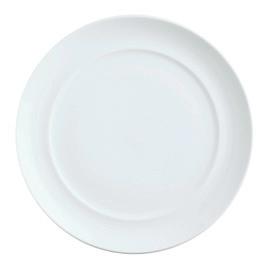
THE BEST FUEL APPS
These apps will help you maintain a balanced, healthy diet, and they’re all available for free:

MyFitnessPal (iOs and Android): Track your daily calorie intake by scrolling through the database to see what you’re eating and when.
Meal Planner Pal (iOs and Android): Organise your healthy eating recipes and the app will
THE FOOD GROUPS
Before embarking on a healthy, balanced diet, it’s useful to know your food groups:
Carbohydrates Found in pasta, cereals and potatoes, carbs have a bad reputation, but they’re crucial for energy.
Fats Not all fats are the same. Unsaturated ‘good’ fats found in oils, nuts and fish are great for your hair, skin and satiety, while saturated ‘bad’ fats, like those lurking in processed foods, can clog up the arteries.
Protein
Found in meat, poultry, dairy, fish and pulses, protein is important for muscle repair, particularly after exercising. MINERALS & VITAMINS
Minerals
These help us release energy from food. Look for them in fruits, vegetables and fish.
Vitamins Lots of vitamins from fresh fruits and vegetables aid concentration and help maintain healthy bones, teeth and skin.
compile a shopping list of all the ingredients that you’ll need.
Carbodroid (Android): Set a daily goal for water intake and chart your progress.
MAINTAINING A BALANCED DIET It’s easy to choose a salad over a burger for lunch and congratulate yourself. But how do you keep up healthy eating in the long term?
First of all, let’s make it clear that a ‘balanced diet’ is just that – a balance. This means that some days you go for the salad, and others you opt for the burger and triple-cooked fries. A healthy, balanced diet is not about cutting out entire food groups – it’s about enjoying food and eating everything in moderation.
Sometimes when we’re trying to be healthy or lose weight, cutting out entire food groups of tasty treats might seem the only solution. But undereating can be just as dangerous as overeating, and it can cause
MALE 12,900kJ (3,083 calories) FEMALE 10,300 kJ (2,462 calories)
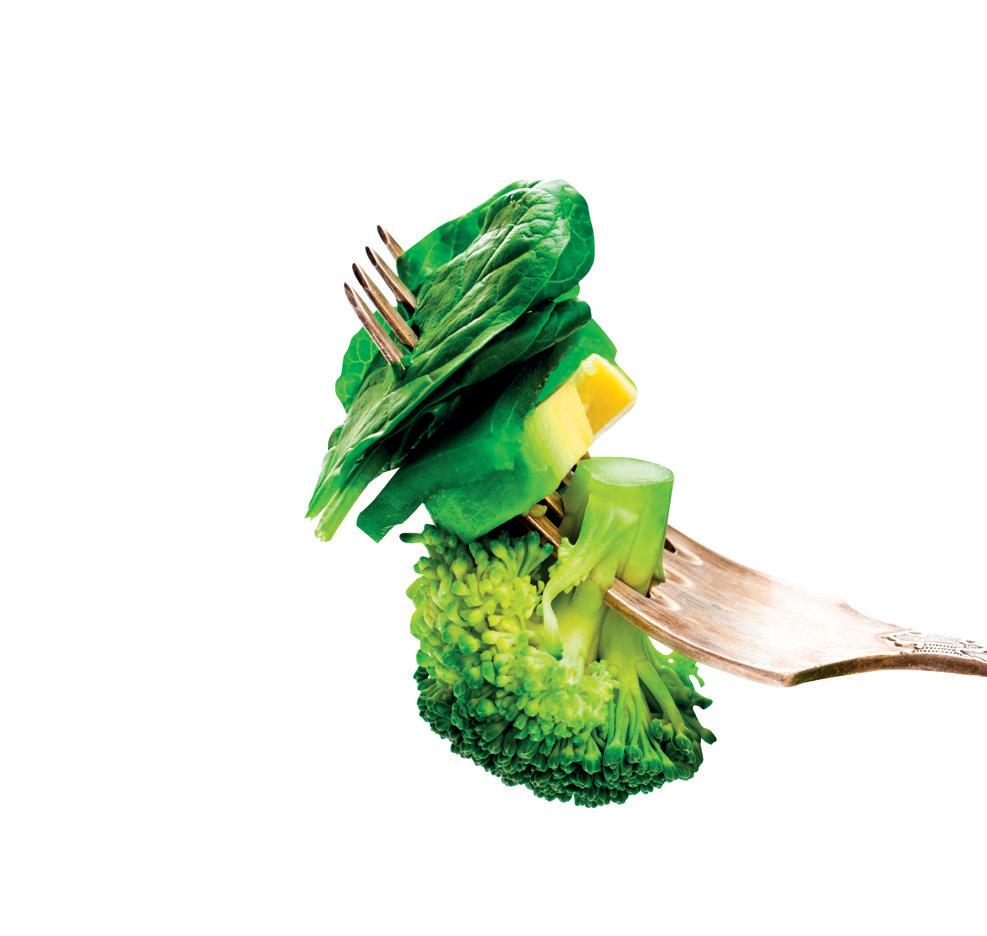
the body to go into starvation mode and retain fat, as well as make you feel rubbish. Cutting out all of the foods you love is also bad news, as when you do let yourself have them again, you might fall off the wagon and overeat…
The table below shows how many calories you should consume (on average) per day to maintain your current weight, but if you’re really active, you may need more. If you eat less than your recommended daily amount, over time you’ll lose weight; if you eat more, you’ll gain weight.
GETTING THE RIGHT CALORIES
Just because you should aim to consume your recommended intake of calories every day, that doesn’t necessarily give you the green light to eat all of those calories in ice cream or cookies. Instead, your calorie intake needs to be varied across the food groups. Use the Eatwell Guide to help get balance of a healthier and more sustainable diet: FRUIT & VEGETABLES
Eat at least five portions of a variety of fruit and vegetables every day Eat beans and pulses, and two portions of sustainably sourced fish per week, one of which is oily (if you’re vegetarian, go for tofu cooked in olive oil). Eat less red and processed meat JUNK FOOD
Eat less often and in small amounts Choose lower fat and lower sugar options
STARCHY CARBS Choose wholegrain or higher fibre versions with less added fat, salt and

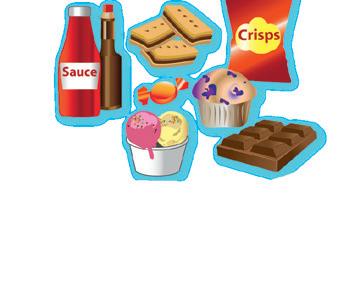
PROTEINS
DAIRY & ALTERNATIVES
sugar OIL & SPREADS
Choose unsaturated oils and use in small amounts

42 STUDENT HEALTH GUIDE ne of the biggest obstacles to healthy eating is not planning O Contrary to popular belief, SNACKS SCHEDULING MEALS A little bit of meal prep will pay off hugely when it comes to your waistline – and your wallet… If you’re following another form of diet or eating regime, do some research as to whether you need to consider supplements – either supplementary food or by way of vitamins – to maintain a healthy diet. TOP TIP ahead. Scheduling is a great habit to get into. When you’re starving but you have no time to prepare a dish, it’s all too easy to grab fast food, which are bad for your body and your bank balance. Check out our guide for what to eat and how to keep on track: it’s fine to snack, as long as you’re eating the right foods most of the time. Nuts, berries, seeds, fruits and oatcakes are wholesome, healthy snacks that will offer you all the right nutrients and energy without the hidden sugars and fats that are often found in cereal bars or crisps. Stock up on Try to sit down to a proper meal in the evening and load up your plate with fresh vegetables. Be creative and try new things. Why not browse YouTube for free recipe ideas? Consider cooking more than you need, so that you can box DINNER
BREAKFAST snacks like these, so that when hunger strikes, you don’t end up the leftovers for lunch or dinner the next day.
When you wake up, you up reaching for a chocolate bar probably haven’t eaten since every time. the previous evening, so it’s likely your body needs food to get going. Get into a morning routine - remember to eat breakfast and allow yourself enough time for it. It doesn’t have to be a huge meal – just a small bowl of porridge or a fresh fruit smoothie will satisfy your hunger, rev up your metabolism and offer enough energy to get through the The healthiest way to do lunch is to pack your own. Taking a home-made meal to uni or work will save loads of money, plus you can ensure that you’re eating healthily. Each Sunday, prepare all five of your weekday lunches, so that you’ll have more time (and less LUNCH Forgetful or disorganised? Take 10 minutes every week to write down on a piece of paper exactly what you aim to eat for breakfast, lunch and dinner each day. Use this as a shopping list to keep you focussed in the aisles. TOP TIP morning. stress!) on weekday mornings.

THE TRUTH ABOUT BREAKFAST “The most important meal of the day is breakfast.” We’ve heard that once or twice (or a million times) before, but is it true? Here are some answers to the recurring breakfast questions…
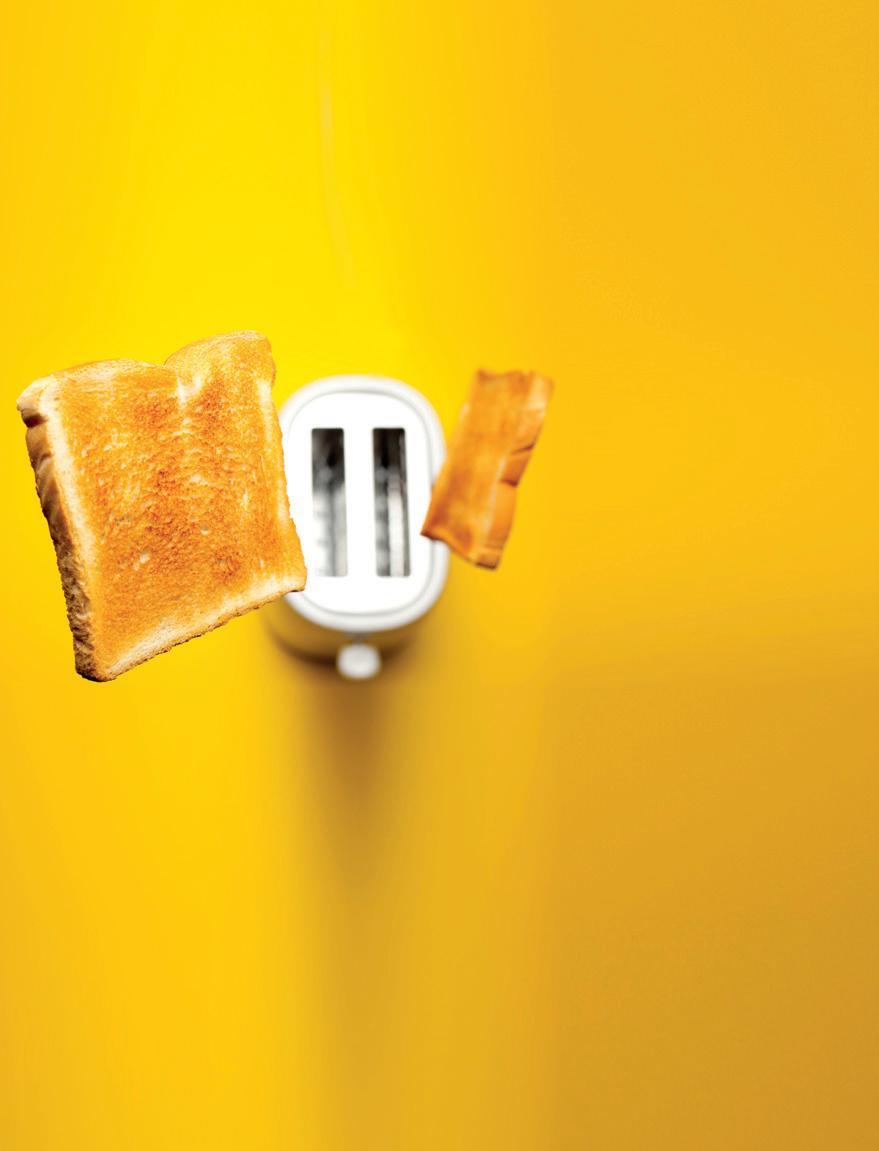
Short on time? Grab a banana. Packed with potassium, vitamins and carbs, bananas improve heart health and help moderate blood levels! TOP TIP

3Should you exercise first thing in the morning on an empty stomach? There’s complicated science behind the answer to this question. In short, it depends on what you’re trying to achieve – if you want to lose fat, this can be achieved by fasted cardio (say, going for a run on an empty stomach). However, if you want to lose fat and maintain muscle, goodquality fuel is required. Either way, if you’re new to exercise or suffer with low blood sugar, always eat something before you exercise.
1Does breakfast kick-start your metabolism? When you break the overnight fast by eating breakfast, you trigger the thermogenesis process and stimulate your metabolism. Eating breakfast also kick-starts our digestive system, which helps our body regulate blood sugar. So, yes, breakfast does get your body ‘going’.
2Will skipping breakfast make you gain weight? In a study, doctors found that while subjects who ate breakfast didn’t lose weight when compared with those who skipped breakfast, eating breakfast did encourage them to be more physically active and eat less throughout the day. This is probably because eating a well-balanced breakfast of slow-releasing carbs and some protein – say, wholemeal toast with a boiled egg – helps to maintain blood sugar levels, giving you steady energy to work out with. So, it’s not a case of whether skipping breakfast will make you gain weight, but will eating breakfast make you more active? THE VERDICT Whilst skipping breakfast may not be as disastrous as our parents made us believe, it’s probably a good idea to always eat some food after you wake. It doesn’t have to be a full continental breakfast – something quick and light, like a banana with peanut butter will provide enough fuel to power you through the morning. And remember to always eat breakfast before important events such as job interviews or exams.
STAY HYDRATED DRINK UP!
What you drink, much like what you eat, can make you feel amazing or “ugh”. Check out our guide to the pros and cons of your favourites
What’s good What’s bad When should you drink it? Substitutes Water It has no calories and no sugar, so it’s the healthiest thing you can drink. Nothing! Drink it throughout the day to stay hydrated. Drink 1.6 to 2 litres throughout the day; more if it’s hot or after exercise. If the taste is too bland, add a slice of lemon or orange to add natural favour. Smoothies Most count toward your five-a-day fruit and veggie target. The naturally occurring sugars in fruit can damage your teeth. Smoothies are healthy in moderation – have no more than one per day. Grab noadded-sugar varieties, or make your own and add greens like kale. Tea & coffee Tea and coffee both contain antioxidants, which have cancer- fighting properties. These drinks are high in caffeine, so they make you feel temporarily alert, then drowsy. Drunk in moderation and early in the day, tea and coffee aren’t harmful. Try green or herbal teas, or de-caf coffee and tea to avoid a caffeine buzz or the ‘jitters’. Fizzy drinks Nothing! That’s why you should avoid them. High in sugar and low in nutrients, which can lead to weight gain. Don’t make this a daily habit. Have one only once in a while as a treat. Sip on sparkling or soda water as a healthier alternative.
Energy drinks Useful for the replenishment of electrolytes during highenergy sporting activities.
These tend to be high in sugar and often contain artificial favours.
Consume sports drinks only during or after high- intensity exercise.
Get the low-cal version of the sports drink, or water it down with lots of ice. Find out how to make your own energy drink at tinyurl. com/zd8vk
VITAMINS & SUPPLEMENTS

There are hundreds of different multi-vitamins and supplements on the market – but do we really need to fork out for them?
The diet of a teenager isn’t always fantastic. Whilst there’s nothing wrong with junk food and take-aways in moderation, eating like this can mean that we don’t always get the right intake of vitamins, minerals and nutrients.
If we eat consciously – meaning, we actually think about what we’re consuming – and make a few healthy tweaks here and there, it’s very likely that we get what we need from our food. However, if you have dietary requirements or allergies, you may be falling short. In such cases, taking supplements is a great way to get what you need.
Vitamin/ mineral
Calcium
Vitamin D Vitamin A Vitamin C Zinc Omega-3 Why is it important? WHY IS IT IMPORTANT? The most common mineral in our bodies, calcium maintains healthy bones and teeth. But calcium alone is not enough – Vitamin D is needed to absorb it.
To absorb calcium more readily, we need to get enough Vitamin D. Also known as retinol, Vitamin A helps your body’s defence against infection and keeps your skin healthy. For healthy skin and to boost your immune system, make sure you have enough Vitamin C. Zinc is needed to maintain a healthy immune system and create new cells and enzymes. Beneficial for brain function, memory and vision. How can I improve my intake? HOW CAN I IMPROVE MY INTAKE? We need around 700mg of calcium per day. Achieve this by consuming dairy products (think: milk and cheese), green vegetables (such as broccoli and cabbage), plus soya beans, nuts and tofu.
Short, daily periods of sun exposure help create Vitamin D, as does consuming oily fish like salmon and mackerel, eggs,
fortified spreads and breakfast cereals. Get this by consuming cheese, eggs, oily fish, milk and yoghurt. Most preformed Vitamin A comes from animal products. If you’re vegan, consider a supplement.
Plenty of citrus fruits (including orange juice), red and green peppers, strawberries, blackcurrants, broccoli and potatoes will give you the 40mg of
Vitamin C you need each day. Men need 9.5mg per day and women 7mg. Get this from meat, shellfish, dairy
foods, bread and cereals. Get this through eating fresh oily fish, like salmon and mackerel. The government recommends two portions per week. Don’t eat fish? Consider a supplement.
SUGAR Sugar gets a lot of bad press – here’s our guide giving you truth about sugar
How bad is it really? Sugar itself isn’t terrible. In fact, ‘naturally occurring sugar’ is found in fruits, carbohydrates (such as rice and pasta) and even milk and we know these foods can be good for us. By contrast, ‘free sugar’ is added to many of our best loved foods to improve the flavour – from cookies to ketchup. These processed foods have increased calories, but little nutrition, meaning we often eat more calories than is needed.
How much is ‘too much’? The World Health Organisation suggests adults should consume no more than 5% of their daily calorie intake of foods containing ‘free sugar’ which is roughly seven sugar cubes or 30g. Unless you are very active, anything over this is unlikely to be a healthy choice.
So, should I eliminate all sugar from my diet? Not necessarily. Whilst some people strive for sugar-free diets (in respect of ‘free sugars’, not ‘naturally occurring sugars’), in reality it would be nearly impossible to achieve this. It would mean never eating out or enjoying any sweet treats at all. It’s perfectly OK to consume sugar in moderation. Depriving yourself from foods you love – whether it be cake, chocolate or a sugar in your tea – is no fun and you put yourself more at risk of falling off the wagon and binging.
What are the effects of consuming too much? Consuming too much sugar can lead to an increase in weight and over time, other medical conditions such as diabetes and heart disease.
TOP TIP There is no need to completely remove sugar from your diet. It is fine to eat your favourite sugary foods from time to time as part of a balanced diet.

5SMALL CHANGES TO DECREASE SUGAR INTAKE
CUT DOWN ON SUGAR IN YOUR TEA OR COFFEE
If you have a couple of spoonfuls in each drink, cut it down over time until you don’t need it any more. LIKE SUGAR ON YOUR CEREAL?
Go for honey instead. It will give you the sweet kick you want in a natural form.
‘LOW FAT’ OFTEN EQUALS ‘HIGH SUGAR’
Often fat is replaced with sugar to keep the taste. If you love the ‘low fat’ option, simply cut the portion size. SMOOTHIES & FRUIT JUICES
Although the sugar may be
‘naturally occurring’, too much sugar can be bad news for your teeth. Use a straw to protect yourself further! SIMPLY DON’T BUY AS MANY SWEET TREATS
If you have them in your cupboard, you are more likely to eat them – opt for fruit instead when the urge to consume sugar strikes.
Packed lunches can be really convenient if you have a dietary requirement or preference and aren’t sure if there’ll be suitable options where you’re going. TOP TIP
Gone are the days of boring limp sandwiches and stale crisps – get creative with your packed lunches to create something tasty and cheap… POWER UP YOUR PACKUP
When you were a kid, it was likely that packed lunches = sandwiches and crisps. And whilst there’s nothing wrong with this, there are now far more appetising ways to prepare lunch for on the go. Whether you’re saving money, catering for a dietary requirement or simply using up the leftovers in your fridge, use our guide to get creative:
SALAD Throwing a salad together is a great way to use up leftovers in the fridge. Add chicken, ham, tuna, lentils, pulses or a hard-boiled egg, together with a simple dressing (balsamic vinegar, a squirt of lemon…) to add taste and variety.
COUSCOUS It’s quick to prepare and easy to mix with vegetables. Make a couple of days’ worth and store in the fridge.
PASTA Opt for wholegrain pasta and whip up a healthy sauce with tinned tomatoes for a wholesome alternative. OK, so if you really want sandwiches, mix them up with different types of bread (baguette or ciabatta, anyone?) and add crisp lettuce leaves to cheese, meat or fish for a balanced, healthy lunch. HOUMOUS A small container of houmous and some carrot sticks or wholegrain breadsticks is a great way to introduce healthy fats and vegetables to your lunchtime meal. VEGETARIAN OPTIONS Enjoy salads with lashings of nuts, cheese and avocado, or
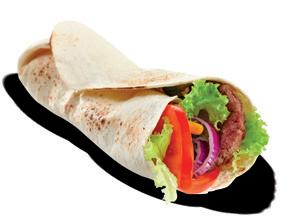
SANDWICHES
any meat-free option. VEGAN OPTIONS Create an awesome mezze of houmous, pitta, tabbouleh, olives and vegetable sticks to keep hunger at bay.
